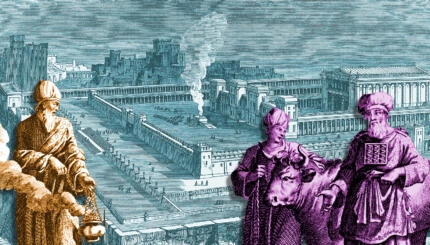Medieval Jews lived from Spain to the Sahara, under the rule of either the Muslims or Christians. (From the destruction of the Second Temple in 70 AD until the founding of Israel in 1948, there was no autonomous Jewish state.) While some commonality of experience existed for Jews living in the domain of the crescent, where there was no separation of church and state; life for Jews under the cross varied as the separation of church and state, coupled with the absence of unified religious law regarding Jews, led to arbitrary application of policy and punishment.
Under Islam, Jews were governed by the Pact of Omar. This contract, established in the seventh century, required non-Muslims living under Muslim rule to abide by a host of discriminatory regulations, such as rising in the presence of a Muslim, dressing in distinctive garb, and (re) building synagogues only when absolutely necessary, and then constructing humble structures.
The Islamic Empire
The Islamic empire expanded and contracted during the Middle Ages to include significant Jewish communities, like Toledo, Grenada, Seville, Constantinople, Salonika, Baghdad, Cairo, and Jerusalem. Generally speaking, the Jews enjoyed security in these places, although occasional instances of persecution and violence erupted.
Spain serves as a useful, though by no means typical, example. Muslims invaded and conquered Andalusia (Spain) in 711. By the mid 8th century they had installed the Persian tradition of statecraft and social life, a strong army and centralized bureaucracy under the leadership of Abd al Rahman. Rahman and the opulent, tolerant rulers that followed him offered to elite Jews the opportunity for social and cultural achievement unprecedented in the medieval world. This was the “Golden Age” for Spanish, North African, and Egyptian Jews.
With your help, My Jewish Learning can provide endless opportunities for learning, connection and discovery.
However, the Golden Age began to crumble in 976 when Andalusia became engulfed in political stability over the question of succession; this disorder lead to Christian attempts to reconquer Spain. Tensions erupted in Grenada, where Samuel ibn Nagrela (993-1055/6) was a Jewish vizier to the court. A Hebrew poet and biblical commentator, he lead Grenada’s armies while wearing robes adorned with inscriptions from the Koran. Muslim leaders accused Jews like Nagrela of breaking the Pact of Omar by seizing excessive power. In 1066, Jewish prominence in many petty kingdoms was squashed and thousands of Jews were slaughtered in Grenada.
Under Christian Rule
By 1248 the Christian reconquest of Spain was successful, and Spanish Jews were subject to new authorities, secular and sacred. From the 11th century on, Jews no longer resided in any given territory in Europe/Christendom by inherent right. Rather their residency hinged on a charter granted by a ruler that put the whole Jewish community under his special protection. In medieval Christian Europe, Jews lived in France and the German lands, Spain and Italy until 1300, when a series of expulsions forced a migration eastward so that by 1500 a majority of European Jews resided in central and eastern regions, primarily Poland. Meanwhile the church, organized into councils at the local, regional, nation, and Lateran (all of Latin Christendom) levels, also counted Jews as part of their agenda. Medieval Lateran decisions reflect the touchstone issues of medieval Jewish Christian relations, including conversion and the Crusades.
Conversion was a central issue in Spain, where the combination of secular and sacred anti-Judaism resulted in decades of forced mass conversions, the most famous example being “The Great Conversion” of 1391 in which 100,000 Spanish Jews converted, 100,000 were murdered and 100,000 hid or fled to Muslim lands. These forced conversions created a large class of conversos, or converts to Christianity. A segment of the converso community still secretly practiced Judaism; these secret Judaizers were known as marranos (lit. pigs) or crypto-Jews.
This large community of new Christians proved impossible to assimilate — whether they chose to practice Judaism or to embrace Christianity. Queen Isabella and King Ferdinand brought the Inquisition, a method of inquiry run by the church to discover and punish heretics, to Spain to deal with this population in 1481.
The Crusades
Conversion also played a role in the Crusades, but in this case, it was Christians that wanted to “convert” the holy land. The purpose of the Crusades was to recapture the holy land for Christianity. They were initiated in 1095 by Pope Urban II. The first crusade began in 1096 and crusades continued for the next 300 years. The first crusade was the most disastrous for the Jews of Europe. Three centers of Ashkenazi Jewry, Cologne, Mainz and Worms were destroyed. However, the bulk of European Jewry emerged from 1096 unscathed and the pope/Church successfully impressed upon the crusading armies the message that the Jews were to be left alone so that in subsequent crusades, anti-Jewish violence in Europe was minimal.
The story of medieval Judaism is one in which the Jews lived as part of societies that aimed for purity and/or supremacy of a faith that was not theirs. Thus Jewish life was influenced significantly by the political machinations of Muslims and Christians.
Ashkenazi
Pronounced: AHSH-ken-AH-zee, Origin: Hebrew, Jews of Central and Eastern European origin.



